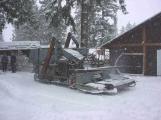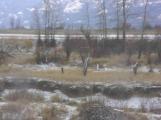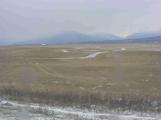39
After a very bumpy drive along the power line, we came across the remains of the oldest dyke in the Creston Valley. This is Englishman's dyke, built in 1893 by the Alberta and British Columbia Exploration Company; the "Eng- lishman" was probably George Alexander. Although the dyke is in very poor repair - it is completely overgrown, and there are large gaps in it - it is still recognisable. The photo on the left was taken from the middle of the borrow pit just north of the dyke. The photo on the right was taken from on top of the dyke, looking south across Boundary Creek to Idaho, only a few hundred feet away.41
Our next stop was Boundary Dyke itself, which stretches east across the Creston Valley just north of Englishman's Dyke. Compared to the dyke we visited earler, where the abandoned dragline sits, Boundary Dyke is extremely narrow, barely wide enough to accommodate Cyril's truck. It's also very high - the highest dyke in the Creston Valley, and the only one that isn't built on a river bank. From its top, we got an excellent view of the old dredge channel near Porthill, Idaho. In this photo, Boundary Creek is visible in the foreground, and the dredge channel can be seen near the middle of the photo.43
This photograph was taken from the spot where Boundary Dyke broke in 1948, looking north across the Reclamation Dyking District. It took about a day and a half for the entire 7,000 acres of the district to flood. Water rushing through the breach created a ravine that remained marshy for decades, until Cyril finally filled it in in the mid-1990s. Ten years later, though, a hint of the ravine can still be seen in the shallow dips and rises in the farmland near the centre of the photo.44
Rocky promontory in the Reclamation Dyking District.21 November 2003
Reclamation Farm, near Creston, BC

45
As we headed back north through the Reclamation Dyking District, Cyril pointed out this rocky promontory, on the west side of Reclamation Road at Granary Road. It was one of the areas of high ground used to safely store equipment out of the reach of floodwaters. Some people claim William-Adolph Baillie-Grohman built a house on a rocky bluff in the west side of the Creston Valley, in anticipation of the reclamation of the farmland. Although no evidence of this house exists, it is generally believed that it was built on this outcropping.46
Pumphouse at the north end of Reclamation Dyking District21 November 2003
Reclamation Farm, near Creston, BC
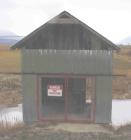
47
At the very north end of the Reclamation Dyking District is this pumphouse. Although it has been covered with aluminum siding, the original wooden construction is still visible below the roof. This little building will be replaced with one of the green metal structures, like the one at Wynndel, in the spring of 2004.48
International TD 35 caterpillar tractor, circa 1935.21 November 2003
Reclamation Farm, near Creston, BC
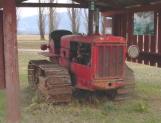
49
Our last stop was at Bob Roger's place, on the original Reclamation Farm established by the Alberta and British Columbia Exploration Company. Bob's family has been farming this land since 1929, and, right alongside the road, is this little International TD-35 caterpillar tractor, built about 1936. Although this one was only ever used for general farm work, it's very similar to the cats that were used during flood control in 1938 and 1948.50
1941 Massey Harris combine arriving at the Creston Museum.25 November 2003
Creston Museum, Creston, BC
